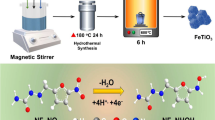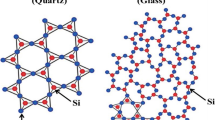Abstract
Rapid detection of organophosphorous (OP) compounds such as paraoxon would allow taking immediate decision on efficient decontamination procedures and could prevent further damage and potential casualties. In the present study, a biosensor based on nanomagnet-silica core-shell conjugated to organophosphorous hydrolase (OPH) enzyme was designed for detection of paraoxon. Coumarin1, a competitive inhibitor of the OPH enzyme, was used as a fluorescence-generating molecule. Upon excitation of cumarin1 located at the active site of the enzyme, i.e., OPH, the emitted radiations were intensified due to the mirroring effect of the nanomagnet-silica core-shell conjugated to the enzyme. In presence of paraoxon and consequent competition with the fluorophore in occupying enzyme’s active site, a significant reduction in emitted radiations was observed. This reduction was proportional to paraoxon concentration in the sample. The method worked in the 10- to 250-nM concentration range had a low standard deviation (with a coefficient of variation (CV) of 6–10 %), and the detection limit was as low as 5 × 10−6 μM.







Similar content being viewed by others
References
Du, D., Wang, M., Cai, J., & Zhang, A. (2010). Sensitive acetylcholinesterase biosensor based on assembly of β-cyclodextrins onto multiwall carbon nanotubes for detection of organophosphates pesticide. Sensors Actuators B Chem, 8, 337–341.
Du, D., Chen, A., Xie, Y., Zhang, A., & Lin, Y. (2011). Nanoparticle-based immunosensor with apoferritin templated metallic phosphate label for quantification of phosphorylated acetylcholinesterase. Biosensors and Bioelectronics, 26, 3857–3863.
Lu, D., Wang, J., Wang, L., Du, D., Timchalk, C., & Barry, R. (2011). A novel nanoparticle-based disposable electrochemical immunosensor for diagnosis of exposure to toxic organophosphorus agents. Advanced Functional Materials, 21, 4371–4378.
Susan, J., Dyk, V., & Pletschke, B. (2011). Review on the use of enzymes for the detection of organochlorine, organophosphate and carbamate pesticides in the environment. Chemosphere, 82, 291–307.
Pohanka, M. (2012). Acetylcholinesterase based dipsticks with indoxylacetate as a substrate for assay of organophosphates and carbamates. Analytical Letters, 45, 367–374.
Aragay, G., Pino, F., & Merkoçi, A. (2012). Nanomaterials for Sensing and Destroying Pesticides. Chemical Research, 112, 5317–5338.
Sassolas, A., Simón, B. P., & Marty, J. L. (2012). Biosensors for Pesticide Detection: New Trends. American Journal of Analytical Chemistry, 3, 210–232.
Mulbry, W. W., Karns, J. S., Kearney, P. C., Nelson, J. O., Mc Daniel, C. S., & Wild, J. R. (1986). Identification of a plasmid-borne parathion hydrolase gene from Flavobacterium sp. by southern hybridization with opd from Pseudomonas diminuta. Applied and Environmental Microbiology, 51, 929–930.
Simonian, A., Good, T., Wang, S., & Wild, J. (2005). Nanoparticle based optical biosenses for the direct detection of organophosphate chemical warfare agent and pesticides. Analytica Chimica Acta, 534, 69–77.
Calleri, E., Temporini, C., Massolini, G., Caccialanza, G., & Penicillin, G. (2004). Penicillin G acylasebased stationary phases. Journal of Pharmaceutical and Biomedical Analysis, 35, 243–258.
Chi-Fang, W., Hyung, J. C., James, J., & Bentley, E. (2002). GFP-visualized immobilized enzymes: Degradation of paraoxon via organophosphorus hydrolase in a packed column. Biotechnology Bioengineering, 77, 212–218.
Luckarift, H. R., Spain, J. C., Naik, R. R., & Stone, M. O. (2004). Enzyme immobilization in a biomimetic silica support. Nature Biotechnology, 22, 211–213.
Du, G. H., Liu, Z. L., Xia, X., Chu, Q., & Zhang, S. M. (2006). Characterization and application of Fe3O4/SiO2 nanocomposites. Journal of Sol-Gel Science and Technology, 39, 285–291.
Arruebo, M., Fernandez-Pacheco, R., Velasco, B., Marquina, C., Arbiol, J., Irusta, S., Ibarra, M. R., & Santamara, J. (2007). Antibody-Functionalized Hybrid Superparamagnetic Nanoparticles. Advanced Functional Materials, 17, 1473–1479.
Choi, J., Kim, J., Lee, Y., Kim, I., Parka, Y., & Hur, N. (2007). Fabrication of silica-coated magnetic nanoparticles with highly photoluminescent lanthanide probes. Chem. Commun. 1644–1646.
Kamelipour, N., Mohsenifar, A., Tabatabaei, M., Rahmani-Cherati, T., Khoshnevisan, K., Allameh, A., Milani, M., Najavand, S., & Etemadikia, B. (2014). Fluorometric determination of paraoxon in human serum using a gold nanoparticle-immobilized organophosphorus hydrolase and coumarin 1 as a competitive inhibitor. Microchimica Acta, 181, 239–248.
Chou, K. S., & Lee, S. J. (2009). Facile methods to synthesize nanaosized iron oxide colloidal dispersion and its characterization. Colloids and Surfaces A: Physicochemical and Engineering Aspects, 336, 23–28.
Hashemifard, N., Mohsenifar, A., Ranjbar, B., Allameh, A., Lotfi, A. S., & Etemadikia, B. (2010). Fabrication and kinetic studies of a novel silver nanoparticles-glucose oxidase bioconjugate. Analytica Chimica Acta, 675, 181–184.
Shanehsaz, M., Mohsenifar, A., Hasannia, S., & Pirooznia, N. (2013). Detection of Helicobacter pylori with a nanobiosensor based on fluorescence resonance energy transfer using CdTe quantum dots. Microchimica Acta, 180, 195–202.
Zekavati, R., Shahabeddin, S., Hashemi, S. J., Rahmani, T., Tabatabaei, M., Mohsenifar, A., & Bayat, M. (2013). Highly sensitive FRET-based fluorescence immunoassay for aflatoxin B1 using cadmium telluride quantum dots. Microchimica Acta, 180, 1217–1223.
Lessard-Viger, M., Rioux, M., Rainville, L., & Boudreau, D. (2009). FRET enhancement in multilayer core-shell nanoparticles. Nano Letters, 9, 3066–3071.
Thakur, S., Kumar, P., Reddy, M., Siddavattam, D., & Paul, A. (2013). Enhancement in sensitivity of fluorescence based assay for organophosphates detection by silica coated silver nanoparticles using organophosphate hydrolase. Sensors and Actuators B: Chemical, 178, 458–464.
Kim, C., Choi, B., Seo, J., Lim, G., & Cha, H. (2013). Site-specific immobilization of microbes using carbon nanotubes and dielectrophoretic force for microfluidic applications. Biosensors and Bioelectronics, 41, 199–204.
Sahin, A., Dooley, K., Cropek, D., West, A., & Banta, S. (2011). A dual enzyme electrochemical assay for the detection of organophosphorus compounds using organophosphorus hydrolase and horseradish peroxidase Sensor. Sensors and Actuators B: Chemical, 158, 353–360.
Pedrosa, V. A., Paliwal, S., Balasubramanian, S., Nepal, D., Davis, V., Wild, J., Ramanculov, E., & Simonian, A. (2010). Enhanced stability of enzyme organophosphate hydrolase interfaced on the carbon nanotubes. Colloids and Surfaces B, 77, 69–74.
Wang, J., Chen, L., Mulchandani, A., Mulchandani, P., & Chen, W. (1999). Remote biosensor for in-situ monitoring of organophosphate nerve agents. Electroanalysis, 11, 866–869.
Mulchandani, P., Mulchandani, A., Kaneva, I., & Chen, W. (1999). Biosensor for direct determination of organophosphate nerve agents. 1. Potentiometric enzyme electrode. Biosensors and Bioelectronics, 14, 77–85.
Roger, K., Wang, Y., Mulchandani, A., Mulchandani, P., & Chen, W. (1999). Organophosphorus hydrolase-based fluorescence assay for organophosphate pesticides. Biotechnology Progress, 15, 517–522.
Mulchandani, A., Pan, S., & Chen, W. (1999). Fiber-optic biosensor for direct determination of organophosphate nerve agents. Biotechnology Progress, 15, 130–134.
Mulchandani, P., Mulchandani, A., Chen, W., Wang, J., & Chen, L. (1999). Amperometric thick-film Strip electrodes for monitoring organophosphate nerve agents based on immobilized organophosphorus hydrolase. Analytical Chemistry, 71, 2246–2249.
White, B., & Harmon, H. (2005). Optical solid-state detection of organophosphates using organophosphate hydrolase. Biosensors and Bioelectronics, 20, 1977–1983.
Lei, Y., Mulchandani, P., Chen, W., & Mulchandani, A. (2007). Biosensor for direct determinationof fenitrothion and epn using recombinant Pseudomonas putida JS444 with surface-expressed organophosphorous hydrolase. Applied Biochemistry and Biotechnology, 136, 243–250.
Acknowledgments
The authors would like to thank Nanozino Co. and Nanosystems Research Team (NRTeam) for financially supporting the present research.
Compliance with Ethical Standards
The authors declare no conflict of interest. No ethical approval was required.
Author information
Authors and Affiliations
Corresponding authors
Rights and permissions
About this article
Cite this article
Khaksarinejad, R., Mohsenifar, A., Rahmani-Cherati, T. et al. An Organophosphorus Hydrolase-Based Biosensor for Direct Detection of Paraoxon Using Silica-Coated Magnetic Nanoparticles. Appl Biochem Biotechnol 176, 359–371 (2015). https://doi.org/10.1007/s12010-015-1579-1
Received:
Accepted:
Published:
Issue Date:
DOI: https://doi.org/10.1007/s12010-015-1579-1




